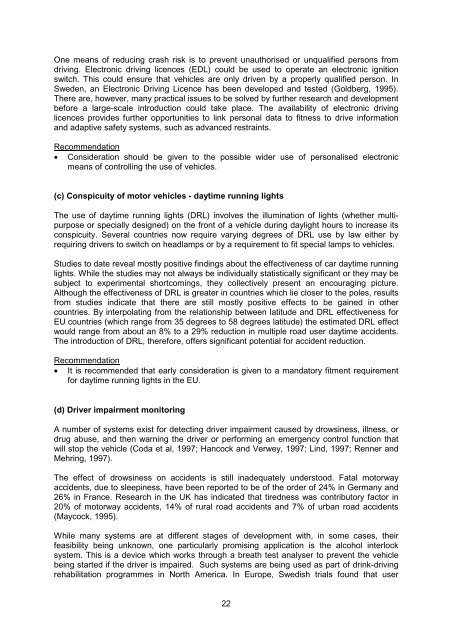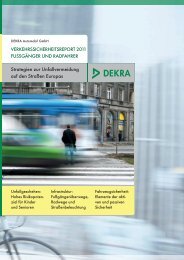PRIORITIES FOR EU MOTOR VEHICLE SAFETY DESIGN
priorities for eu motor vehicle safety design - ETSC
priorities for eu motor vehicle safety design - ETSC
You also want an ePaper? Increase the reach of your titles
YUMPU automatically turns print PDFs into web optimized ePapers that Google loves.
One means of reducing crash risk is to prevent unauthorised or unqualified persons from<br />
driving. Electronic driving licences (EDL) could be used to operate an electronic ignition<br />
switch. This could ensure that vehicles are only driven by a properly qualified person. In<br />
Sweden, an Electronic Driving Licence has been developed and tested (Goldberg, 1995).<br />
There are, however, many practical issues to be solved by further research and development<br />
before a large-scale introduction could take place. The availability of electronic driving<br />
licences provides further opportunities to link personal data to fitness to drive information<br />
and adaptive safety systems, such as advanced restraints.<br />
Recommendation<br />
• Consideration should be given to the possible wider use of personalised electronic<br />
means of controlling the use of vehicles.<br />
(c) Conspicuity of motor vehicles - daytime running lights<br />
The use of daytime running lights (DRL) involves the illumination of lights (whether multipurpose<br />
or specially designed) on the front of a vehicle during daylight hours to increase its<br />
conspicuity. Several countries now require varying degrees of DRL use by law either by<br />
requiring drivers to switch on headlamps or by a requirement to fit special lamps to vehicles.<br />
Studies to date reveal mostly positive findings about the effectiveness of car daytime running<br />
lights. While the studies may not always be individually statistically significant or they may be<br />
subject to experimental shortcomings, they collectively present an encouraging picture.<br />
Although the effectiveness of DRL is greater in countries which lie closer to the poles, results<br />
from studies indicate that there are still mostly positive effects to be gained in other<br />
countries. By interpolating from the relationship between latitude and DRL effectiveness for<br />
<strong>EU</strong> countries (which range from 35 degrees to 58 degrees latitude) the estimated DRL effect<br />
would range from about an 8% to a 29% reduction in multiple road user daytime accidents.<br />
The introduction of DRL, therefore, offers significant potential for accident reduction.<br />
Recommendation<br />
• It is recommended that early consideration is given to a mandatory fitment requirement<br />
for daytime running lights in the <strong>EU</strong>.<br />
(d) Driver impairment monitoring<br />
A number of systems exist for detecting driver impairment caused by drowsiness, illness, or<br />
drug abuse, and then warning the driver or performing an emergency control function that<br />
will stop the vehicle (Coda et al, 1997; Hancock and Verwey, 1997; Lind, 1997; Renner and<br />
Mehring, 1997).<br />
The effect of drowsiness on accidents is still inadequately understood. Fatal motorway<br />
accidents, due to sleepiness, have been reported to be of the order of 24% in Germany and<br />
26% in France. Research in the UK has indicated that tiredness was contributory factor in<br />
20% of motorway accidents, 14% of rural road accidents and 7% of urban road accidents<br />
(Maycock, 1995).<br />
While many systems are at different stages of development with, in some cases, their<br />
feasibility being unknown, one particularly promising application is the alcohol interlock<br />
system. This is a device which works through a breath test analyser to prevent the vehicle<br />
being started if the driver is impaired. Such systems are being used as part of drink-driving<br />
rehabilitation programmes in North America. In Europe, Swedish trials found that user<br />
22



